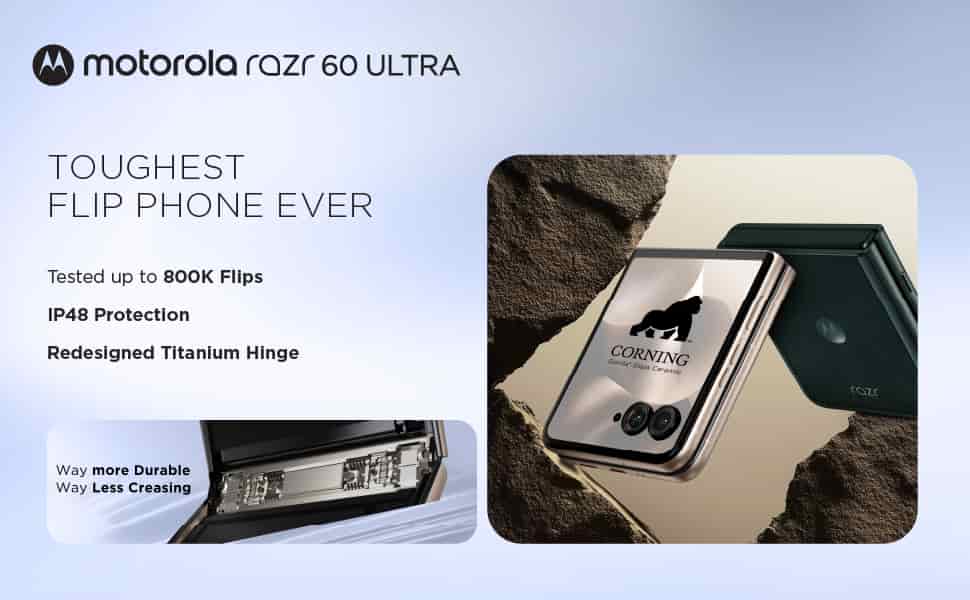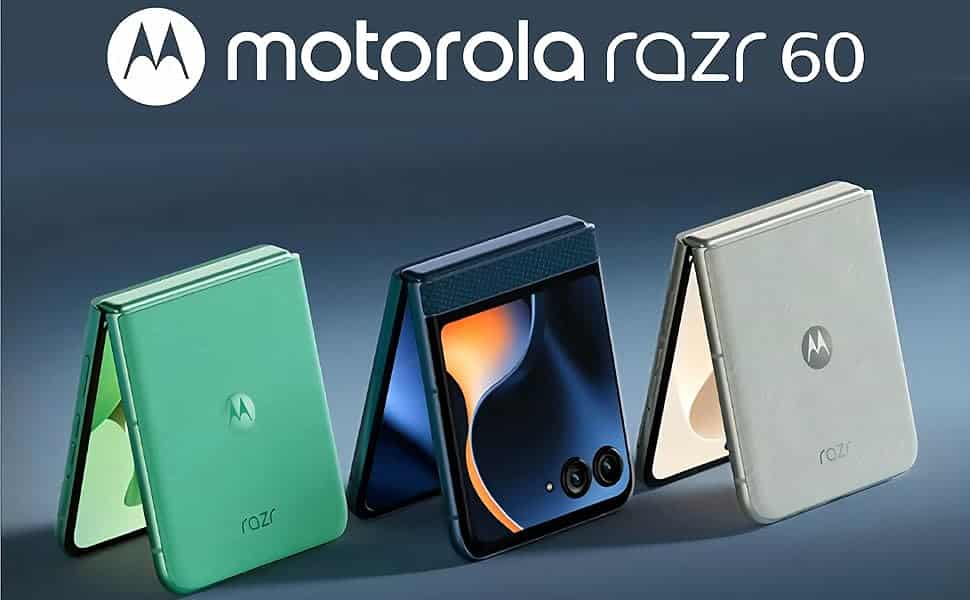The foldable world just got its next big statement piece — the Motorola Razr 60 Ultra. This isn’t just another attempt to revive nostalgia; it’s a statement that says, “flip phones can be powerful, premium, and futuristic.”
Motorola has taken everything it learned from the last few Razr generations and seems to have gone all out — new materials, a larger display, better durability, smarter AI, and the fastest charging we’ve ever seen in a flip. The result? A device that makes even regular slab phones feel… well, a little boring.
If you’ve been holding off on foldables because of durability doubts or compromises, the Razr 60 Ultra might just change your mind.

A Design That Screams Luxury — Built Like a Supercar
The first thing you notice when you unbox the Razr 60 Ultra is how premium it feels. It’s not just about glass and metal anymore — Motorola has gone wild with material innovation.
The brand is offering three luxurious finishes, and each one tells a different story.
Alcantara: The same premium material you’d find in Ferraris or Lamborghinis now wraps a smartphone. It feels soft, grippy, and unapologetically premium — something that instantly sets it apart from every other flip out there.
Real Wood: Yes, actual wood on a smartphone. Each unit has a slightly different grain pattern, giving it a handcrafted vibe that feels unique.
Pantone Rio Red (Vegan Leather): For those who love color and flair, the Pantone-certified vegan leather finish looks bold and premium — and Motorola is, in fact, the world’s first brand to make a Pantone-validated flip phone.
The hinge is another engineering masterpiece. Made from titanium, it’s rated for a whopping 800,000 folds — that’s around 20 years if you open and close it 100 times a day. And the best part? The crease is barely noticeable. Use it for a few minutes, and you’ll forget it’s even a folding screen.
Adding to its toughness, the cover display is protected by Gorilla Glass Ceramic, again a world’s first on a flip phone, and it even packs an IP48 rating for dust and water resistance. You can tell — this is not your delicate first-gen foldable. It feels solid, premium, and purpose-built.
Two Displays That Redefine What a Flip Phone Can Do

Let’s talk screens — because Motorola just went overboard in the best possible way.
The Inner Display: Stunning and Seamless
Once unfolded, you’re greeted with a massive 7-inch LTPO P-OLED display running at 165Hz with 1.5K resolution. That’s laptop-size territory. But what’s even crazier is the brightness — it hits 4,500 nits peak, which means you can comfortably use it in direct sunlight without squinting.
And that crease? Practically invisible. Motorola’s hinge design really pays off here. Whether you’re scrolling through Instagram or editing photos, you almost forget this is a foldable screen.
The External Display: A True Secondary Phone
Now, the 4-inch cover screen is where Motorola truly flexes. It’s not just for checking notifications — it’s fully functional. You can run Google Maps, YouTube, reply to messages, or even play games like BGMI right from that smaller display.
It’s bright (up to 3,000 nits), buttery smooth at 165Hz, and super responsive. Honestly, you could spend hours on the outer display alone and never feel the need to open the phone. Both displays also support Dolby Vision, making the overall viewing experience exceptional.
Performance and AI: Power Meets Personality
Under the hood, the Razr 60 Ultra is a beast. It’s powered by the Snapdragon 8 Elite chipset — Qualcomm’s top-tier processor — paired with 16GB LPDDR5X RAM and 512GB UFS 4.0 storage.
Benchmarks? Crazy high — over 2.7 million on AnTuTu. Real-world performance? Super smooth. Apps launch instantly, animations glide, and multitasking feels effortless.
But yes, being a compact flip phone, it can get slightly warm during extended gaming. Motorola seems to have tuned it well — performance throttling is minimal, and most users won’t notice any slowdowns.
Moto AI 2.0: A Smarter Flip Experience
Motorola is betting big on AI this year, and it shows. The Razr 60 Ultra features on-device AI, and it even comes with a dedicated AI button on the side.
One standout feature is “Look & Talk” — just prop the phone on your desk, look at it, and talk. No need to touch it. You can ask it to take a picture, read your schedule, or summarize notifications — all completely hands-free.
There’s also “Predict Your Next Move,” which anticipates what you might want to do next based on your current screen (say, creating a playlist after watching a video). Plus, you get the freedom to choose between Google Gemini, Microsoft Copilot, or Perplexity AI — whichever assistant suits your style.
This is easily one of the most forward-thinking AI implementations we’ve seen on a flip phone — maybe even on any phone.
Cameras: Triple 50MP System That Surprises
The Razr 60 Ultra brings a major camera upgrade — the world’s first triple 50MP camera system on a flip.
Main Camera: 50MP with OIS, delivering sharp, vibrant shots with excellent dynamic range.
Ultra-Wide Camera: 50MP again, which doubles as a macro shooter. The color science stays consistent across both lenses.
Front Camera: A third 50MP sensor that’s great for selfies and video calls.
The Pantone color validation ensures that tones look accurate, and honestly, skin tones come out beautifully natural. The ultrawide camera’s 122° FOV adds versatility, while video recording supports up to 8K at 30fps and 4K 60fps across all sensors, including Dolby Vision capture.
And thanks to the foldable form factor, you can use the main sensor for selfies — which completely changes the game. The flex hinge even lets you use it as a mini tripod, ideal for creators or vloggers.
Battery and Charging: The Fastest Yet on a Flip
Battery life has always been a weak spot for foldables — but not this time. The Razr 60 Ultra packs a sizable 4,700mAh cell, and it actually performs better than expected. The trick? That smart outer display. You can do so much without unfolding, saving tons of battery.
Charging is another area where Motorola leads the pack — 68W fast charging gets you from 0 to 100% in under 45 minutes. You also get 30W wireless and 5W reverse wireless charging.
Yes, the charger is included in the box — a rare luxury in 2025.
Software and Longevity

Out of the box, you get Android 15 with Motorola’s clean Hello UI on top. It’s near-stock Android but with smart tweaks that actually help — like intuitive gestures, better split-screen handling, and AI-assisted shortcuts.
Motorola promises three years of major OS updates and four years of security patches — respectable, though Samsung and Google still offer longer. But given how polished the experience feels here, most users won’t mind.
Verdict: The Flip That Finally Gets It Right
Let’s be real — flip phones have always been a compromise between style and practicality. But the Razr 60 Ultra finally nails both.
You get:
✅ A gorgeous design with premium materials,
✅ A stunning pair of displays,
✅ Flagship-grade performance,
✅ AI that actually feels useful, and
✅ Cameras that can hold their own against non-folding flagships.
At ₹99,999 (or ₹79,999 with offers), it’s not cheap — but this is no fashion gimmick. This is a fully capable flagship that just happens to fold.
If you’re someone who values design, innovation, and the joy of something different — the Razr 60 Ultra is not just worth considering, it’s probably the flip phone you’ve been waiting for.
Razr 60 Ultra FAQs
Q1. Is the Razr 60 Ultra waterproof?
It’s rated IP48 — it can handle dust and splashes but isn’t meant for full submersion.
Q2. Does the Razr 60 Ultra overheat during gaming?
It can get warm under heavy load, but Motorola’s cooling optimizations keep it stable in daily use.
Q3. Can I use apps on the external display?
Yes, the 4-inch cover screen supports almost all apps, including YouTube, Google Maps, and messaging apps.
Q4. Is the charger included in the box?
Yes — Motorola includes a 68W fast charger in the box.




